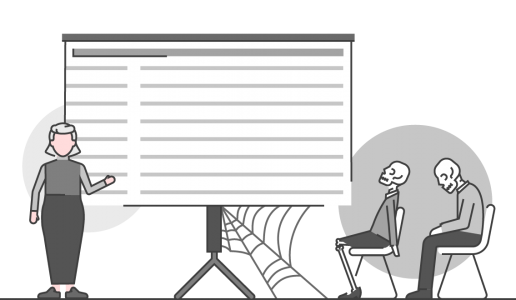PowerPoint gives people a lot of freedom, but in a large organisation this can be more of a curse than a blessing. Because users are given too much freedom when designing slides, there’s often a lack of consistency in corporate presentations. Slides don’t match each other, or company guidelines. The end result of this is that your brand is undermined, slides look unprofessional, and your audiences are left confused. Maybe you’ve noticed these problems in your organisation, but what can you do?
Assess your corporate presentation template
If your organisation is suffering from poor presentations it’s time to lift the hood and figure out what’s going wrong!
Start by taking a good look at your template. It’s likely that the people creating your corporate presentation template don’t really understand it. They’re probably amazing at their day-to-day design or marketing work, but PowerPoint? That’s not their specialty. And most PowerPoint users definitely don’t understand templates or masters and needlessly reinvent the wheel spending too long looking for things, and even longer struggling to make changes.
Unfortunately, without a proper PowerPoint template, presentations can be a bit of a mess. Colours aren’t programmed in properly or aren’t on-brand. The title, the logo, and all the other background elements jump all over the place slide to slide. Images aren’t proper placeholders so when an element is deleted, the layout’s ruined forever. It’s difficult to combine slides from different decks and as for page numbers, they come and go as they please… As things scale, the problems only get worse. Throw in a rebrand or a sub brand or two and your problems can increase exponentially. All the good work your marketing department does in making sure your message is communicated clearly and cohesively is lost in a puff of poor PowerPoint template smoke.
The fact of the matter is that PowerPoint templates are surprisingly complex, especially on the enterprise scale. That one file has to support the work of thousands of people communicating a vast range of information. Getting a professional in to assess your current PowerPoint template/s, do a presentation needs analysis of your organisation and build a robust template or set of templates could transform the presentations produced by your employees (and the time it takes).
That said, if you want to check out the basics of PowerPoint templates yourself, we’ve got a detailed introduction here: How to create PowerPoint templates.
Invest in training
Once you’ve got a robust template, you need to make sure your users know how to build on it. Many of us use presentations to communicate on a weekly, if not daily, basis. And though it would be nice, getting professionals in to work on every slide might not be the most cost effective option for every organisation. What is a good investment, however, is training. A lot of people have had hardly any training in creating and delivering presentations, but it forms a huge part of many different roles. A little high-quality training goes a long way!
You can train your people on how to create presentations. Most employees aren’t designers so it can take them a long time to make presentations, and PowerPoint can encourage the wrong behaviour (not least with its famous ‘Click to add text’ instruction!). So train your teams on layout and design, visualisation, graphs and charts, image manipulation, interactivity, how to use your new templates, multimedia, and animation. Standardised training based on your brand helps encourage consistency across your company and improve the quality of presentations people are creating.
Then, take the next logical step and train employees on how to present effectively. How do they use the presentation tech at your organisation? Are they crafting materials that are easy to present? And how should they actually deliver their slides? Investing in training could help you get the results you’re after.
We’ve got free resources to help individuals with all of these things both on our blog and in the weekly free masterclasses we run. We also offer group training which can be tailored to your organisation’s needs.
Support your staff with tools
Though both a robust template and well-trained teams will get you far, there are also tools out there designed to help enterprise organisations get control of their presentations once and for all.
At BrightCarbon we’re all passionate PowerPoint users and we’re well aware of PowerPoint’s pitfalls. So, we developed our free PowerPoint add in BrightSlide to make our lives easier. It’s a productivity tool that uses industry-standard shortcuts to boost workflows and provides amazing, extra functionality that speeds up slide creation. We’ve got lots of resources on how to get the most out of BrightSlide, and can provide custom training for organisations who want to level up their employees’ skills.
BrightSlide is great for streamlining day-to-day slide creation but doesn’t solve for some of those broader issues around conflicting templates, lack of access to brand assets, and lack of understanding of your brand. So here’s a not at all subtle plug for our tool BrandIn. It’s pretty powerful.
With BrandIn you get a Brand workspace in the PowerPoint ribbon, allowing you to control what gets used, and hide what doesn’t. The workspace contains the colours, shapes, tables, charts, SmartArt, and fonts you want your employees to stick to. By removing the things you don’t want to see in presentations, you help users do things right. If it’s too hard to access branded design elements, presentations inevitably stray off-brand. That’s why we build BrandIn with a searchable, curated library of your pictures, slides, logos, and illustrations — all optimised for use in presentations. It’s easier to stay on-brand than to stray off it, so that’s what your employees do. BrandIn also includes a Brand Check which identifies and fixes common mistakes. Wrong colours or fonts? Fixed. Off-brand shadows or bevels? Removed. Brand name without legal marks? Added!
We could keep going and going, talking about Model Slides, managing templates and masters, sub-brands and more. But if you want to know more – just get in touch.
Making sure the corporate presentations produced across your organisation consistently look professional and on-brand without draining your employees’ time is a true challenge. However, if you assess your current materials, invest in training, and equip your teams with the tools they need you’ll see a significant improvement in the quality and efficiency of presentation development in your company.
Leave a comment




